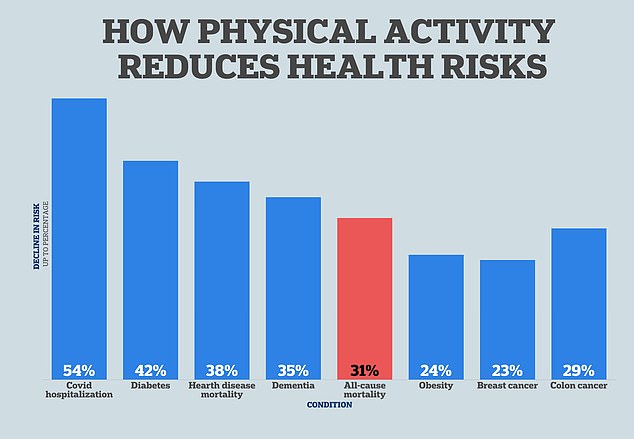Extensive blood tests or multiple body scans may not be necessary to determine your health status.
It turns out that a classic training move could reveal the truth.
Experts at the Mayo Clinic said push-ups are a good measure of muscle strength and endurance.
The exercise engages most major muscle groups throughout the body, including the legs, abs, shoulders, back, and arms.
The move involves starting face down on the floor, with your toes bent, your elbows bent, and your hands at shoulder height.
Keeping your body straight and parallel to the floor, push yourself up until your arms are straight and you are on your hands and feet.
Then, lower yourself back down to complete a full push-up and continue until you need to stop and rest.
Beginners can perform a modified version performed on their knees and hands.
Based on age and gender, the Mayo Clinic gave a target number for push-up counts, starting with men and women age 25. Men should aim to perform 28 push-ups at a time and women should work towards 20 to “show a good level of fitness.”
As age increases, the target goal decreases.
In the 35-year-old age group, the number drops by one for women, while men should be able to perform 21 push-ups, according to the online guide.
According to Mayo Clinic experts, the number of push-ups you can do is a good indicator of your fitness level.
Ten years later, until he was 45, the Mayo Clinic It says that women should be able to do 14 push-ups, while the count is 16 for men.
For 55-year-olds, the count drops to 10 push-ups for women and 12 for men.
For older age, as listed by the Mayo Clinic, both men and women age 65 should be able to do 10 push-ups at a time.
While the guide is touted as an indicator of good fitness levels, fitness experts say it should be taken with a grain of salt.
New York-based personal trainer Natalya Alexeyenko told DailyMail.com that she disagrees with the Mayo Clinic’s suggestions.
She explained: ‘I respect various experiments and studies, but in this case, I rely more on my personal experience training individuals.
‘Most of my clients live a moderate lifestyle and exercise two or three times a week.
“Given this, I think realistic standards might be lower for women by three to five repetitions and higher for men with athletic experience by five to 10 repetitions compared to the Mayo Clinic recommendations.”
Alexeyenko also highlights that the physical strength and fitness levels of both men and women are influenced by numerous factors, “making it difficult to establish strict correlations between age and push-ups.”
He adds: “Training history, past injuries or surgeries, current lifestyle, nutrition, stress levels, posture, joint mobility, sleep quality and recovery all play a role in time to determine how many push-ups someone can do.
Caroline Beckwith, also a Manhattan-based fitness director, agrees with this sentiment.
She told this website: ‘I teach classes here and train a lot of older men and women, and what I see in person versus what I read online doesn’t really match up.

There is now evidence that just 20 minutes of physical activity a day dramatically reduces the risk of cancer, dementia and heart disease.
‘I teach a class that normally has about 20 attendees between 40 and 65 years old. We do push-ups in each class for 40 seconds.
‘Of all of them, there may be only one person who can do them starting from the plank position. Everyone else is on their knees.
‘Pushups are truly a full-body exercise, requiring core strength as well as your upper body and glutes. I think the most important thing, so far, when it comes to developing strength is to set realistic goals and work on them consistently.’
A 2019 studywhich only included men, found that adults who could finish push-ups were 96 percent less likely to develop heart disease.
And regular exercise has been associated with a host of benefits, including a 29 percent reduced risk of colon cancer; a 31 percent reduction in the risk of all-cause mortality; 35 percent lower risk of dementia; a 38 percent lower risk of death from heart disease; and a 42 percent lower risk of diabetes.
And while exercise is beneficial at any age, the CDC notes that “additional benefits for older adults include a lower risk of falls, more years of independent living, and better brain health.”
The CDC’s official exercise guidelines recommend that people get 150 minutes of moderate-intensity physical activity per week, or about 20 minutes per day, including two days of dedicated strength training.
Moderate activities include bicycling, dancing, walking, jogging, brisk walking, and swimming, and muscle-strengthening exercises include weight lifting, push-ups, pull-ups, and squats.


